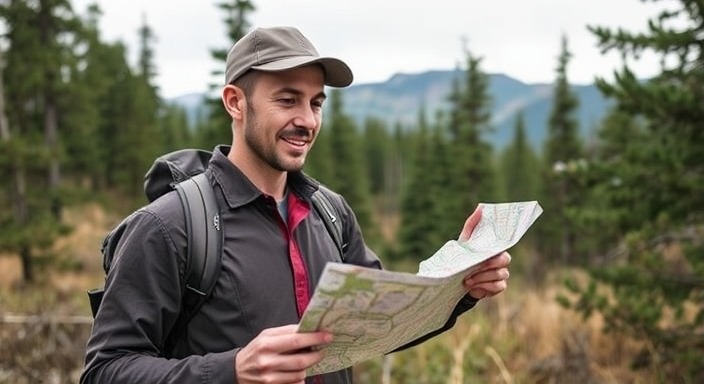Exploring the great outdoors is an exhilarating experience, but getting lost on a trail can quickly turn an adventure into a stressful situation. Whether you’re a beginner or a seasoned hiker, understanding navigation basics is essential to ensure a safe and enjoyable journey. This guide covers everything you need to know about navigating trails like a pro.
1. The Importance of Trail Navigation Skills
Hiking offers stunning views and physical benefits, but the unpredictability of nature can pose challenges. Here’s why mastering navigation is critical:
- Safety: Avoid wandering into dangerous areas or getting stranded.
- Confidence: Knowing your location boosts your peace of mind.
- Preparedness: Trails may lack clear signage, and weather conditions can obscure paths.
With proper navigation skills, you’ll be better equipped to handle unexpected situations.
2. Essential Tools for Trail Navigation
Equipping yourself with the right tools is the first step to staying on track. Here are the must-haves:
a) Trail Maps
- Paper Maps: Reliable and don’t rely on batteries.
- Digital Maps: Apps like AllTrails and Gaia GPS provide detailed trail data.
b) Compass
- A basic compass can help you determine direction when trails are unclear.
- Learn how to use it with a map for accurate navigation.
c) GPS Devices
- Handheld GPS units are highly accurate and work offline.
- Smartphones with GPS apps are convenient but require charged batteries.
d) Trail Markers and Signage
- Pay attention to blazes, cairns, and signs along the trail to stay oriented.
3. Understanding Trail Maps
Reading a map is a fundamental skill for any hiker. Here’s how to interpret key features:
- Contour Lines: Indicate elevation changes. Close lines mean steep terrain, while wide spacing means gentle slopes.
- Trail Symbols: Look for dashed or solid lines representing different trail types.
- Landmarks: Identify features like rivers, peaks, and trailheads to locate yourself.
4. Tips for Staying on the Right Path
a) Plan Ahead
- Research the trail’s route, difficulty, and potential hazards.
- Share your plan with someone who can alert authorities if needed.
b) Stick to Marked Trails
- Straying off designated paths increases the risk of getting lost and harming natural habitats.
c) Regularly Check Your Position
- Compare your location with the map at landmarks or intersections.
- Use your compass to confirm you’re heading in the right direction.
d) Recognize Trail Markers
- Blazes: Painted marks on trees or rocks.
- Cairns: Stacked stones, often used in rocky areas.
5. What to Do If You Get Lost
Even with precautions, getting lost can happen. Stay calm and follow these steps:
a) STOP
- Stop moving to avoid wandering further off course.
- Think about your last known location.
- Observe your surroundings for landmarks.
- Plan your next steps carefully.
b) Retrace Your Steps
- Backtrack to the last point where you were confident about the trail.
c) Use Your Tools
- Refer to your map and compass to identify your position.
- Check your GPS device for nearby waypoints or trailheads.
d) Signal for Help
- Use a whistle, mirror, or bright clothing to attract attention.
- Stay in open areas where rescuers can spot you.
6. Navigating in Different Conditions
a) Low Visibility
- Stick close to landmarks and use your compass frequently.
- Avoid risky terrain like cliffs or rivers.
b) Dense Forests
- Mark your path using biodegradable trail tape or natural indicators.
- Stay attentive to trail markers.
c) Snow-Covered Trails
- Snow can obscure paths. Follow GPS routes or pre-planned waypoints.
- Look for tree blazes or other high markers.
7. Training Your Navigation Skills
Practice makes perfect. Build your confidence by:
- Joining Navigation Workshops: Many outdoor organizations offer classes.
- Practicing on Easy Trails: Test your skills on well-marked paths before attempting remote areas.
- Simulating Scenarios: Practice using maps, compasses, and GPS at home or in a local park.
8. Common Navigation Mistakes to Avoid
- Over-Reliance on Technology: Batteries die; always carry a backup map and compass.
- Ignoring Trail Markers: Missing signs or blazes can lead to confusion.
- Rushing: Take time to confirm your position and avoid costly detours.
9. Frequently Asked Questions
Q1: What’s the easiest way to learn navigation?
Start with basic map-reading skills and practice using a compass on local trails.
Q2: Can I rely solely on GPS?
While convenient, GPS devices can fail. Always carry a physical map and compass as backups.
Q3: How do I know if I’m off the trail?
If you no longer see markers or the path becomes unclear, stop and consult your tools to confirm your location.
10. Conclusion
Mastering trail navigation is a vital skill for anyone who loves the outdoors. With the right tools, preparation, and practice, you can confidently explore trails without fear of getting lost. Remember to stay aware, plan ahead, and enjoy the journey. Happy hiking—and safe navigating!

